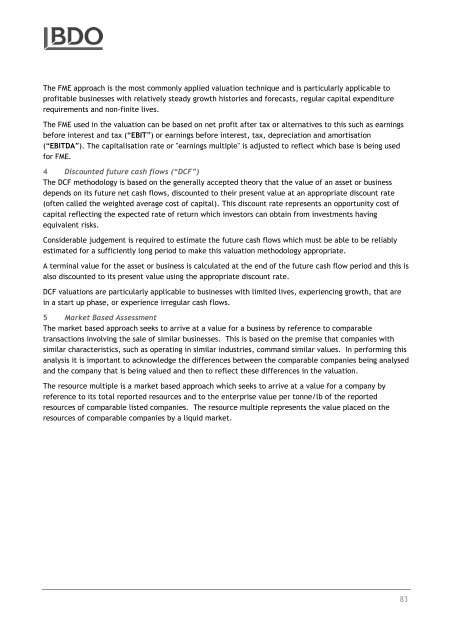Update on Merger with Polymetals - Notice of Meeting
Update on Merger with Polymetals - Notice of Meeting
Update on Merger with Polymetals - Notice of Meeting
You also want an ePaper? Increase the reach of your titles
YUMPU automatically turns print PDFs into web optimized ePapers that Google loves.
The FME approach is the most comm<strong>on</strong>ly applied valuati<strong>on</strong> technique and is particularly applicable to<br />
pr<strong>of</strong>itable businesses <strong>with</strong> relatively steady growth histories and forecasts, regular capital expenditure<br />
requirements and n<strong>on</strong>-finite lives.<br />
The FME used in the valuati<strong>on</strong> can be based <strong>on</strong> net pr<strong>of</strong>it after tax or alternatives to this such as earnings<br />
before interest and tax (“EBIT”) or earnings before interest, tax, depreciati<strong>on</strong> and amortisati<strong>on</strong><br />
(“EBITDA”). The capitalisati<strong>on</strong> rate or "earnings multiple" is adjusted to reflect which base is being used<br />
for FME.<br />
4 Discounted future cash flows (“DCF”)<br />
The DCF methodology is based <strong>on</strong> the generally accepted theory that the value <strong>of</strong> an asset or business<br />
depends <strong>on</strong> its future net cash flows, discounted to their present value at an appropriate discount rate<br />
(<strong>of</strong>ten called the weighted average cost <strong>of</strong> capital). This discount rate represents an opportunity cost <strong>of</strong><br />
capital reflecting the expected rate <strong>of</strong> return which investors can obtain from investments having<br />
equivalent risks.<br />
C<strong>on</strong>siderable judgement is required to estimate the future cash flows which must be able to be reliably<br />
estimated for a sufficiently l<strong>on</strong>g period to make this valuati<strong>on</strong> methodology appropriate.<br />
A terminal value for the asset or business is calculated at the end <strong>of</strong> the future cash flow period and this is<br />
also discounted to its present value using the appropriate discount rate.<br />
DCF valuati<strong>on</strong>s are particularly applicable to businesses <strong>with</strong> limited lives, experiencing growth, that are<br />
in a start up phase, or experience irregular cash flows.<br />
5 Market Based Assessment<br />
The market based approach seeks to arrive at a value for a business by reference to comparable<br />
transacti<strong>on</strong>s involving the sale <strong>of</strong> similar businesses. This is based <strong>on</strong> the premise that companies <strong>with</strong><br />
similar characteristics, such as operating in similar industries, command similar values. In performing this<br />
analysis it is important to acknowledge the differences between the comparable companies being analysed<br />
and the company that is being valued and then to reflect these differences in the valuati<strong>on</strong>.<br />
The resource multiple is a market based approach which seeks to arrive at a value for a company by<br />
reference to its total reported resources and to the enterprise value per t<strong>on</strong>ne/lb <strong>of</strong> the reported<br />
resources <strong>of</strong> comparable listed companies. The resource multiple represents the value placed <strong>on</strong> the<br />
resources <strong>of</strong> comparable companies by a liquid market.<br />
83




